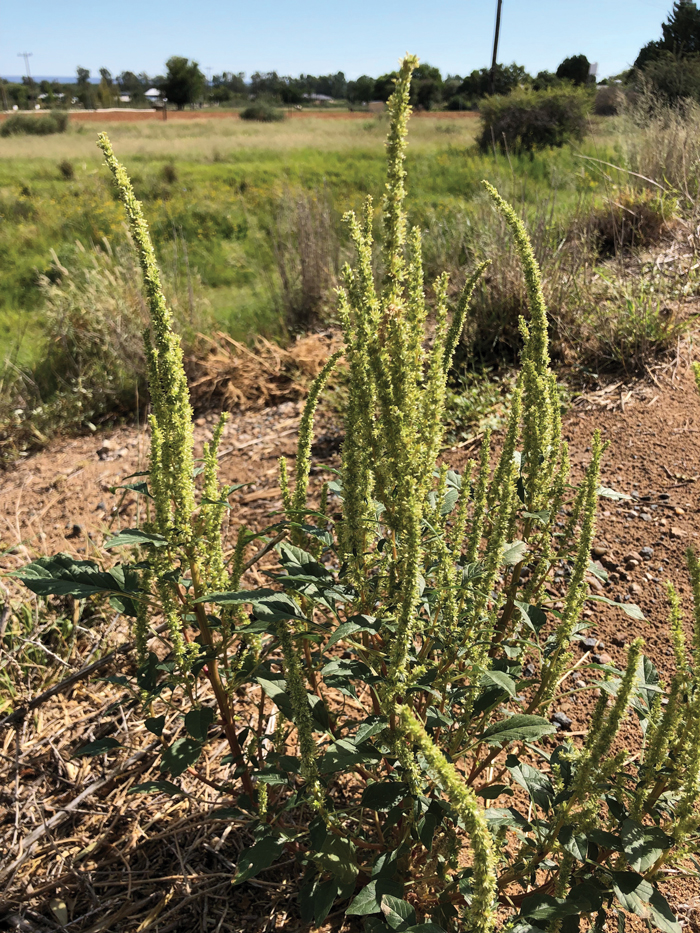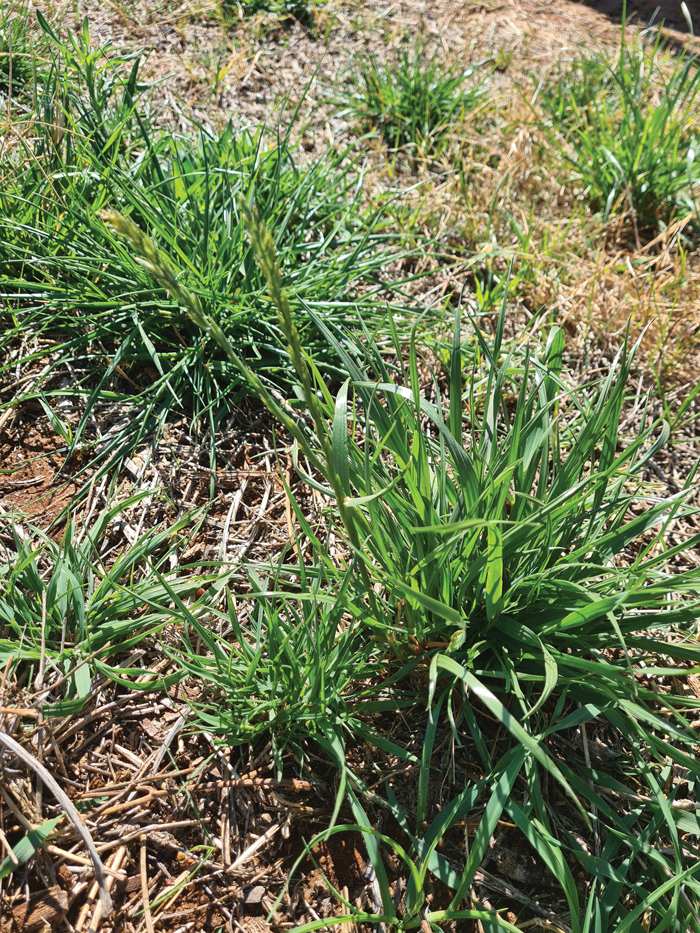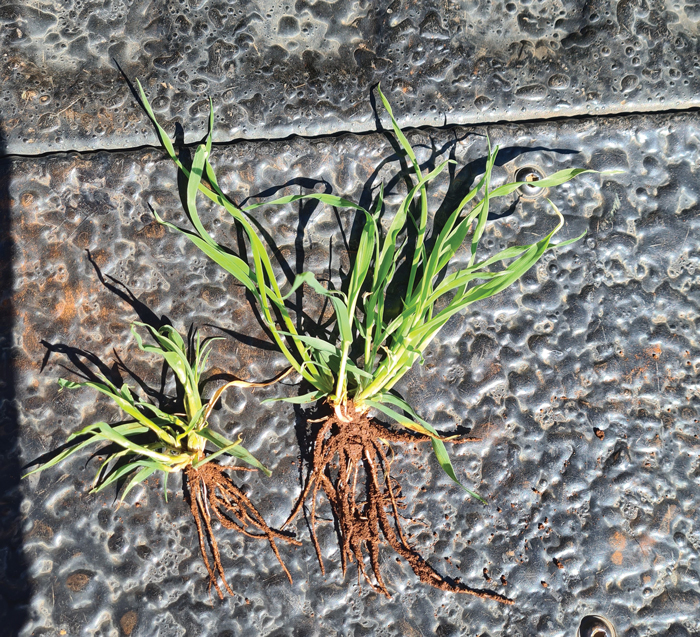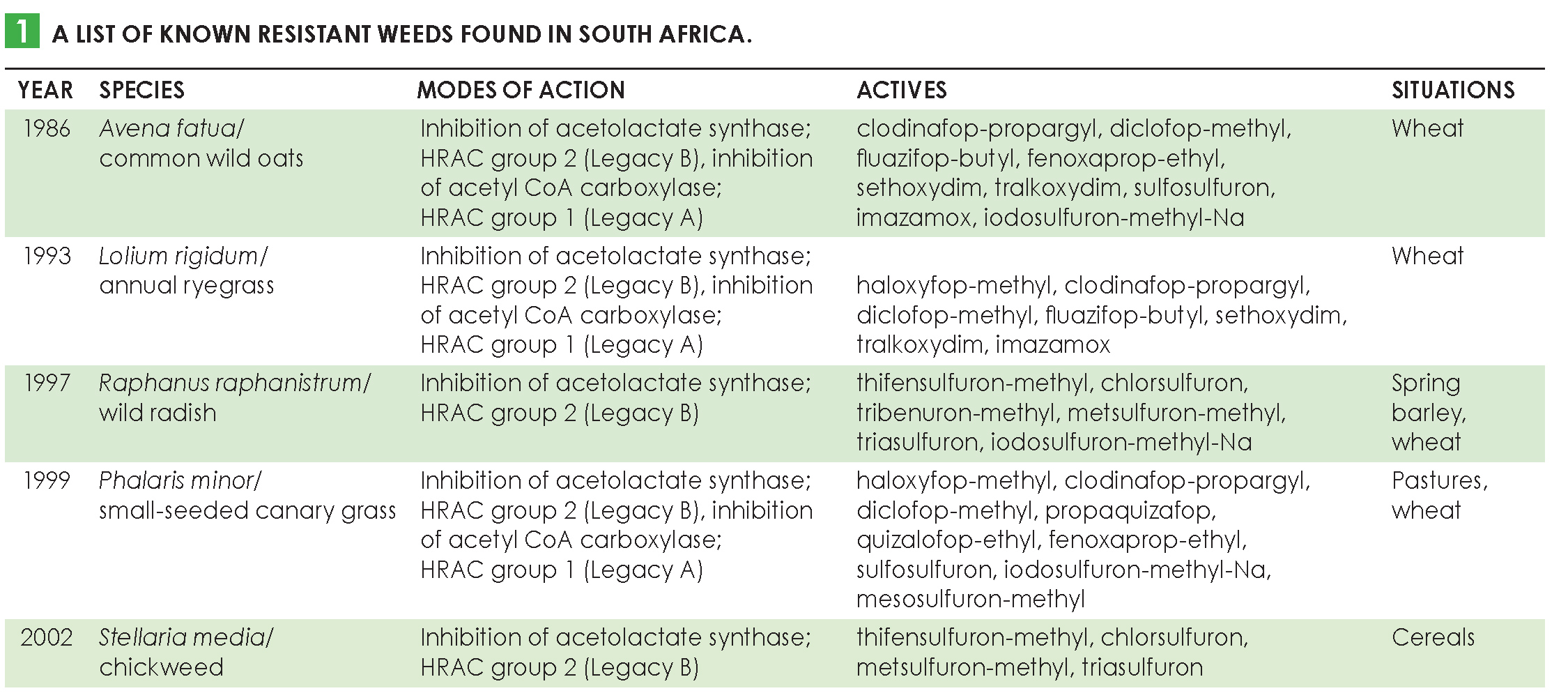
editor, SA Graan/Grain
Herbicide resistance is a well-known occurrence in many crops in South Africa. Since the first confirmed case of herbicide-resistant wild oats in 1986, various cases of herbicide resistance have been confirmed annually.
As herbicide resistance is able to increase and spread over seasons, it is important to understand its workings and the correct control measures needed to manage weed populations. SA Graan/Grain approached experts in the field to find out how producers can better manage the challenge.
How do weeds become resistant?
Dr Gerhard Verdoorn, operations and stewardship manager at CropLife SA, explains that all living organisms have inherent mechanisms to overcome environmental stressors such as heat, cold, drought and natural pests. He adds that anthropomorphic stressors such as pesticides may be foreign to living organisms, but pesticides act upon receptors in the biosystem where the systems may inherently have defence mechanisms against the impacts of pesticides.
‘In the population dynamics of a species, the most adaptable individuals are the ones that survive the stressors such as pesticides and become more resistant to the modes of action than the broad spectrum of individuals in the population. This is called sensitivity shift. In simple terms, a population of a species becomes less sensitive to a pesticide over successive generations and may at a certain stage be resistant to certain pesticide modes of action.
‘Weeds compete with agricultural crops for water, nutrients and sunlight, hence the need to control them for fear of losing crops. Herbicides are commonly used as a weed control tool, while cultivation practices play a very important role in preventing weeds from impacting on plant health and production. Incorrect use of herbicides, such as not using the correct dosage or applying herbicides at the wrong growth stage of the weeds, inadvertently leads to sensitivity shift and ultimately resistance. Herbicide labels offer sound guidance on correct use of the products, which is sadly often ignored with resultant herbicide resistance issues,’ explains Dr Verdoorn.
The problem is that resistance development or sensitivity shift are seldom seen in the early stage of the resistance cycle. Dr Verdoorn explains that it goes largely unnoticed, because producers use higher herbicide dosages to combat weeds that are difficult to control, without considering sensitivity shift. ‘It only becomes reality when weeds stretch their muscles and stand tall against double or even higher dosages of herbicides. All weed species should be viewed with suspicion, because individuals in all populations of all species have resistant genes that, at some time, will catalyse resistance to certain herbicide modes of action. Ryegrass is well-known in the Western Cape wheat fields as a problematic weed, but it is likely that summer rainfall weeds will be present, causing challenges of a different nature for producers. It is not only grain producers that struggle with weeds. Fruit orchards and vineyards are also susceptible to weed invasion. If Palmer amaranth ever arrives in the Western Cape, it will place all producers in a serious predicament.’

Photo: Prof J Vorster, SAHRI, UP
Types of resistance
According to Ingrid Boshoff, technical lead: Herbicides at Syngenta South Africa, herbicide resistance can be split into two major classes: target-site resistance (TSR) and non-target-site resistance (NTSR).
TSR, she explains, is the most common form of resistance and refers to changes that occur relating to the target site of the herbicide within the weed plant. One type of change that can occur is a change in the structure of the target protein known as a conformational change. ‘Imagine a key fitting into a lock where the herbicide molecule is the key, and the binding site is the lock. When the lock changes, the key no longer fits. This results in the decreased efficacy of the herbicide. Other changes that can occur are an increase in the expression of the protein or a duplication in the copies of the gene containing the target site. Both these result in the plant having an increased number of target sites.’
NTSR, on the other hand, refers to the transportation of the herbicide molecule to the binding site within the weed. According to Ingrid, there are several things that could go wrong along the way as the weed plant tries to protect itself. ‘One of these defence mechanisms is to reduce the translocation of the herbicide. Translocation refers to the movement of sugars or nutrients to different areas within the plant. The herbicide will also move along the same path as the sugars. Thus, if the plant reduces translocation, it also reduces the movement of the herbicide, slowing its arrival to the site of action. Another mechanism is increasing the metabolic detoxification of the herbicide. This means that the plant increases production of enzymes that can break down the herbicide. An example of this mechanism is with Lolium rigidum against diclofop herbicide – this common grass weed developed the ability to increase metabolism of diclofop by 10%. This increased metabolism was enough to produce a 30-fold difference in sensitivity to the herbicide. Thirdly, the weed can also sequester the herbicide which immobilises or traps the herbicide at a location within the plant. All these obstacles will result in less herbicide reaching the binding site at the site of action.’


The difference between TSR and NTSR gives important insight into how to manage herbicide-resistant weeds. With resistance management, alternating herbicides with different modes of action (groups) are very important. With NTSR there is the added option of considering different formulations as management tools.
Most recently, a major case of resistance was reported with the identification of Amaranthus palmeri and possible resistance to several herbicide groups. Researchers are still in the process of publishing results to add this case on the global HRAC list for South Africa. This weed exhibits classic TSR against glyphosate by overexpression of the EPSPS gene. ‘It is important to have good knowledge of the weeds in your field to better manage them and prevent resistance from developing. It is also important to know when poor control could be the result of a resistant population or can be attributed to something else,’ says Ingrid.

Herbicide resistance findings from ARC-Small Grain
According to Hestia Nienaber, researcher at ARC-Small Grain, their research shows that ryegrass was the biggest grassweed concern to producers in South Africa. This weed is listed as the most problematic weed with regard to herbicide resistance in the world, resulting in worldwide research programmes specifically focussed on ryegrass. Several other weeds have also been a concern as hard to control or herbicide-resistant. These include grassweeds like wild oats, little seeded canary grass and ripgut brome as well as broad-leaved weeds like wild radish, buckhorn plantain and wild buckwheat.
‘When looking at ryegrass, it is clear that confirmed herbicide-resistant ryegrass biotypes have increased significantly. Another significant finding is that although herbicide resistance started in the Western Cape, it has now spread to several other provinces, including the Northern and Eastern Cape.’
Nienaber says resistance to several different herbicide groups have been confirmed. These groups include:
- glycine/group G/9 (for example glyphosate);
- pyridinium/group D/22 (for example paraquat);
- group A/1 (FOPs, DIMs and DENs); and
- group B/2 (ALS inhibitors).
‘In recent years, more research has been focussed on identifying target-site herbicide resistance in especially grassweeds in wheat and barley. TSR screening for herbicides from group A/1 and group B/2 was predominantly conducted. The screening for TSR is done with molecular markers and is conducted as an in-season screening method for producers. Molecular marker screening results can be available within two to five days, but only allows the researcher to screen for TSR. Glasshouse trials are conducted to screen for other mechanisms of resistance. Screening for resistance to glycine and pyridinium herbicides are, for example, conducted in the glasshouse.
‘A four-year research project on TSR in barley showed that most of the received ryegrass samples had TSR to group A/1 and/or group B/2 herbicides. Where 86% of all tested samples were sensitive/negative to the markers in the 2018/2019 season, only 25% of the tested samples were sensitive/negative to the markers in the 2021/2022 season. This is troublesome, as almost all herbicides available to producers for post-emergence weed control fall within one of these two groups.’
According to Nienaber, the results from a wild oats screening survey indicated that most wild oats populations showed resistance to group A/1 herbicides, although nearly 50% of the same populations showed TSR to group B/2 herbicides as well.
What can South Africa learn from Mediterranean countries in terms of weed resistance management?
‘Apart from the smaller numbers of weeds that are resistant to herbicides when compared to other countries, South Africa has another advantage in that our cultivation and crop spraying equipment is generally much younger and technologically more advanced than that of most European producers,’ explains Dr Verdoorn. ‘Better equipment offers better application, which in turn acts as a barrier against sensitivity shift. South Africa may be very far from Europe or the Americas, but our agriculture is certainly on par with theirs, if not better,’ he adds.
‘At the 2018 Herbicide Resistance Summit in Europe, Josef Soukup of the Czech University of Life Science in Prague, delivered alarming news about unique resistance cases in European countries. Grass species like wild oats, Italian ryegrass, black grass, Bromulus and several other weeds affected more than 10 million hectares of cereals, with France being the most affected with 50 unique resistance cases. Weeds were often resistant to more than one herbicide mode of action, which leaves producers at a loss for solutions. Weed resistance to glyphosate was most prevalent in ryegrass species and fleabane species. Compared to South Africa, we see a similarity with Italian ryegrass in wheat and Conyza species all over the country. This should ring the alarm bells for South African cereal and maize producers because of their strong reliance on glyphosate.’
Dr Verdoorn concludes that our most important take-home message from the European Union is that we are still at the dawn of weed resistance in the winter rainfall areas, but producers need to implement resistance management immediately if they hope to escape the situation that developed in Europe. ‘Switching between different herbicide modes of action is perhaps the founding principle of preventing sensitivity shift, but all the other elements as discussed above must also be built into an effective and integrated weed management programme. Arguments about costs should be frowned upon, because the final question in herbicide resistance management is: “Do you want to grow winter crops sustainably over a long period of time at slightly elevated production costs, or do you want to grow winter crops only for a few more years before resistant weeds beat you hands down?”’
Monitoring resistance
The Herbicide Resistance Action Committee (HRAC) of CropLife International (which also has a strong presence in South Africa in collaboration with CropLife SA), was established to monitor resistance development in weeds and to offer mitigation measures, while categorising herbicides according to their respective modes of action. The number of weeds that are challenging producers globally is sitting at a staggering 478 biotypes within 252 weed species. ‘South Africa is not as bad as some of the northern hemisphere countries, but we do have a couple of weed species that pose serious challenges to crop producers. The most recent and perhaps scariest of all is Amaranthus palmeri that was discovered close to Douglas in the Northern Cape in 2016. This weed species is already resistant against six different herbicide modes of action and poses a very serious sustainability risk to grain producers,’ explains Dr Verdoorn.
Close monitoring of weeds that are no longer effectively controlled by herbicides is key to understanding the problem and should initiate the implementation of different control practices. It is also important to report these weed populations to HRAC South Africa. Please report this to CropLife at info@croplife.co.za and the HRAC SA chair, Cullen Botes, at cbotes@winfieldunited.co.za.
Steps to prevent resistance
- Move to integrated weed management immediately and incorporate mechanical weeding in cultivation practices.
- Check labels of herbicides for its resistance codes and switch between different modes of action on a regular basis; the HRAC website (https://www.hracglobal.com), smartphone app and the Herbicide MOA poster (https://croplife.co.za/HRACMOA) offer good descriptions of herbicide modes of action.
- Follow label directions to the letter and do not deviate from dosage rates and application volumes.
- Choose optimal weather conditions for herbicide application.
- Apply herbicides when weeds are still very young.
- Remove weeds that show resistance by desiccating and burning to prevent resprouting or seed dispersal.
For more information read ‘Proactive weed management from a global perspective’ by Dr Gerhard Verdoorn on www.sagrainmag.co.za.





























